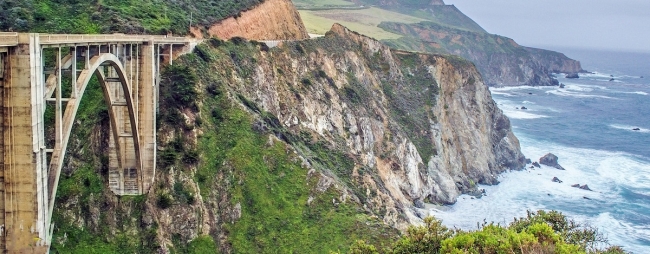Assessing Climate Change Vulnerabilities on California Highways
WSP USA worked closely with Caltrans to develop a study assessing climate impacts on the State Highway System and is continuing this work by prioritizing assets for further study.
Published 09-29-20
Submitted by WSP

Originally published on WSP Insights
Raging wildfires currently devastating the West Coast are a grim reminder of one of the vulnerabilities in the region intensified by climate change; impacting daily life and highlighting uncertainties of the reliability of critical highway infrastructure in the region.
To prepare for climate hazards and establish more resilient, sustainable transportation infrastructure, the California Department of Transportation (Caltrans) completed a statewide climate change vulnerability assessment for the California State Highway System. The study, which was performed by WSP USA in collaboration with Caltrans, evaluated all 12 Caltrans districts.
“The purpose of the study was to assess how climate hazards could change over the coming century and present physical risks to the State Highway System,” said Mike Flood, project manager for WSP USA. “The process introduced a range of technical processes that had to be tailored to California and transportation engineering needs. This data effort alone was the first – and only – one of its kind to date.”
WSP evaluated future projections for five main climate hazards: temperature rise, wildfire, changes to precipitation, sea level rise and storm surge. The study identified areas along the highway that could be exposed to these stressors.
“We considered how these changes may affect highway design,” added Annika Ragsdale, report development lead for WSP USA. “For example, pavement design is based in part on high and low temperatures. So, as temperatures rise, inputs to design should change along with them, rather than continue to be based off historical temperatures.”
Key Findings
While vulnerabilities varied by district, the study uncovered several trends that present a statewide concern.
It is expected that by 2055, an estimated 7,550 miles of the California State Highway System could lie in high wildfire risk locations under a high emissions scenario. In addition, approximately 45 miles of the highway system could be inundated by 20-24 inches of sea level rise. This impact increases to 77 miles if there is a 100-year storm event.
“Each district is vulnerable to climate change in some way based upon the projections we used,” Ragsdale said. “In some cases, district staff already notice problems on the ground and this effort helped them start to look forward to what the future holds.”
This study is an essential first step for Caltrans to understand how climate change could affect the highway system and the travelling public. The data used in the report is available to all the Caltrans districts and can be used during site evaluations or project planning to evaluate potential impacts.
For example, coastal districts can use the sea level rise and surge data to identify areas that are exposed to inundation or temporary flooding before putting a new project in place. The findings also support Caltrans in its discussions with stakeholders and other state agencies engaged in climate adaptation planning.
“The reports have generated a lot of interest with district staff and it is getting them thinking about the issue,” Flood said. “The assessment is expected to be used for helping inform planning-level decisions at Caltrans.”
Shifting Needs
The study posed several challenges as research was being conducted, which required flexibility and adjustments for the team along the away. The approach to climate projects was evolving as the project was being delivered.
Originally, the client was mainly interested in the technical aspects of the assessment and the data it would produce. But as wildfires and state climate policies drew additional attention to climate adaptation, those officials became more interested in developing a report that was accessible to government officials as well as the public.
That shift led to a change in course to create not only the technical deliverables needed to chart the direction, but also to create summary reports that are highly visual and easier to understand.
“This was a huge change in the original scope of work for the project and required additional staff, time and budget,” Flood said. “To develop these summary reports, we had to coordinate very closely with district staff and their many stakeholders.”
There was also a high level of interest in the study expressed by environmental agencies, many of which provided comments on the assessment, with particular interest in decision-making strategies, requesting collaboration with Caltrans on adaptation actions.
“The process is very technical and new, so we worked closely with the Caltrans districts and their stakeholders to walk everyone through the process to the point that they were comfortable with it,” Ragsdale said.
She described the summary reports as “innovative”, unlike anything she has seen before. Patrick Kresl of WSP’s project visualization team, was critical in developing the summary report format and graphics which have been well received by the client.
“They’re engaging, contain tons of good information, and they tell a compelling story for each Caltrans district,” Ragsdale said. “It was a lot of hard work putting them together, but I’m happy with how they turned out.”
Expanding Vision
Already, WSP has committed many hours of coordination, map-making, writing, editing, design work and continuous communication with Caltrans to complete the statewide climate change vulnerability assessment. But the work is far from over.
“We are expanding upon the vulnerability assessment, drilling all the way down to the asset level to help Caltrans identify and prioritize their most vulnerable assets along the State Highway System,” Flood said. “Eventually, these assets should undergo site-specific reviews to confirm vulnerabilities and identify opportunities for adaptation. In other words, we want to ground-truth what the projections are saying in these locations and then find ways to protect that asset from climate change.”
WSP also developed a high-level report called the Caltrans Adaptation Strategy Report.
“We met with Caltrans staff to understand how they were beginning to think about climate change, what their concerns were, and how they thought climate change considerations should be incorporated into agency practices,” Flood said.
After those interviews and a literature review, WSP prepared the Adaptation Strategy Report to provide suggestions on how Caltrans can make climate change resiliency a core function and value of the agency. It also provided recommendations for how to begin to adapt to climate change at a statewide level.
“I am proud of this work and what the team accomplished; it was a challenging project and we pulled it off,” Ragsdale said. “WSP has a great handle on how to complete climate change assessments such as this one, and having the opportunity to work with Caltrans, which is seen as a national leader in this regard, has been a great experience.”

WSP
WSP
WSP is among the world's largest environmental, engineering, advisory and sustainability consulting firms, with more than 55,000 professionals worldwide. We design lasting solutions in the buildings, transportation, energy, water and environment markets, and develop equitable, ESG-centered strategies that help organizations and communities adapt to changing conditions and become more resilient. Reckon with the past. Innovate for the future. Learn more at wsp.com.
More from WSP

